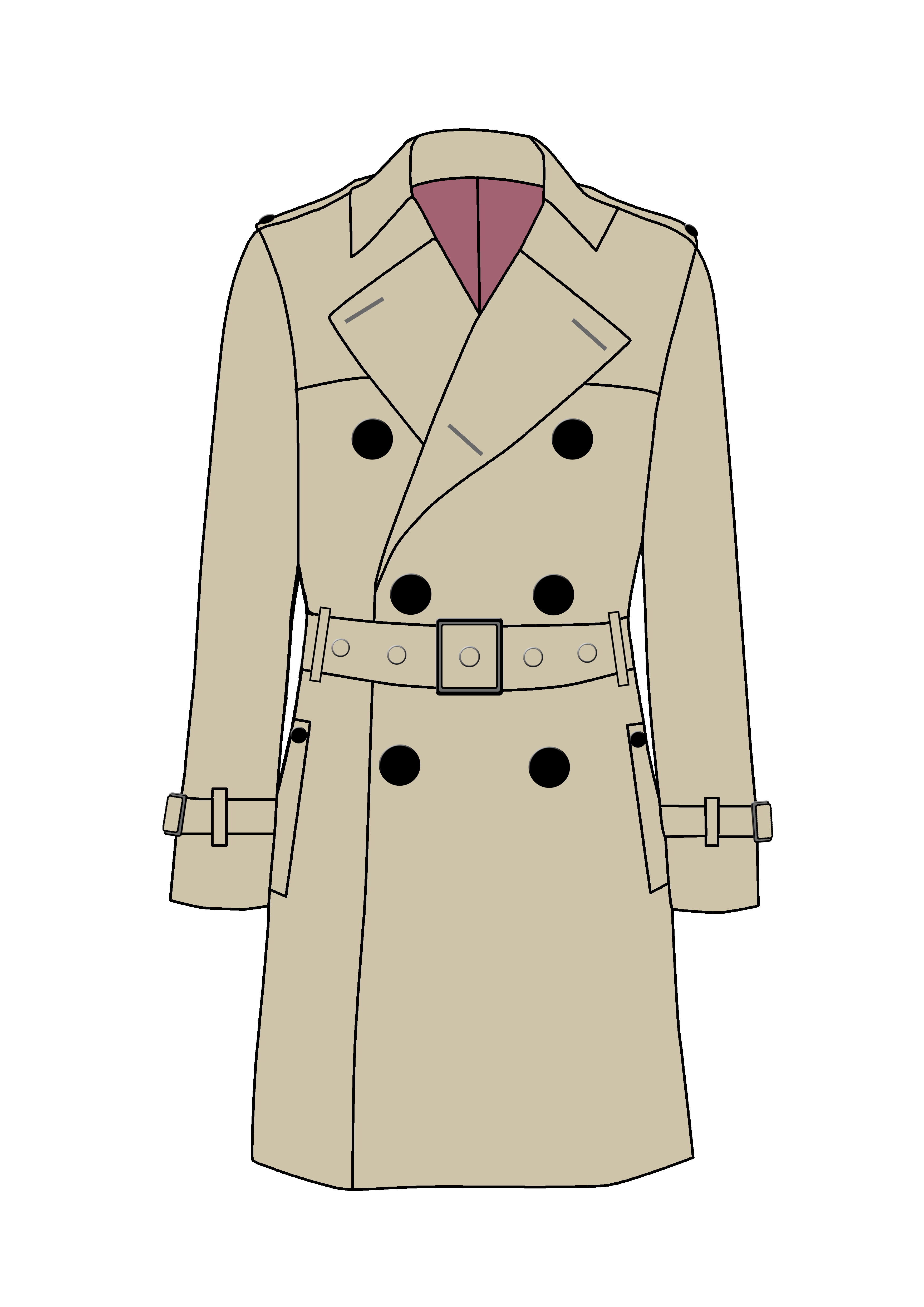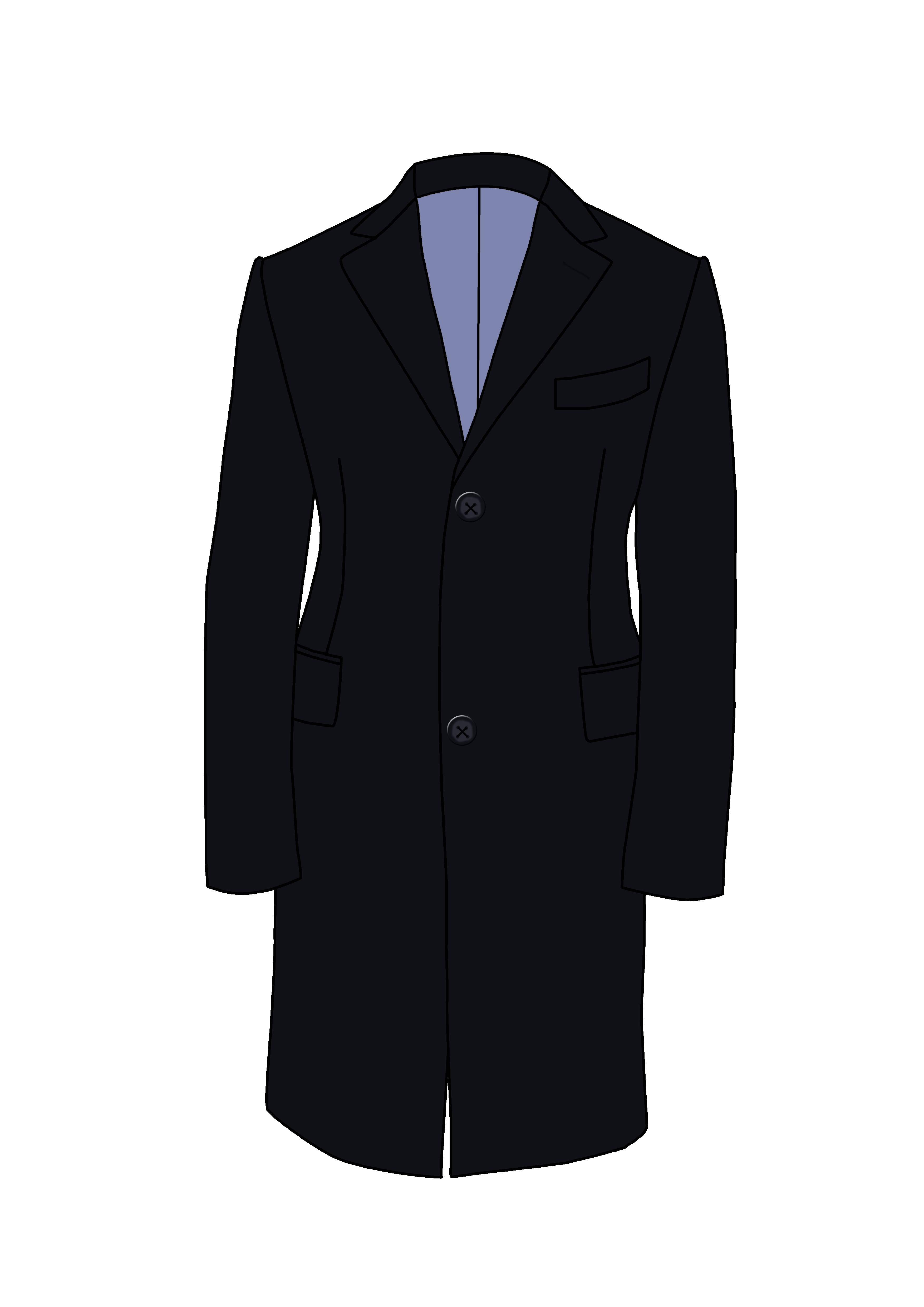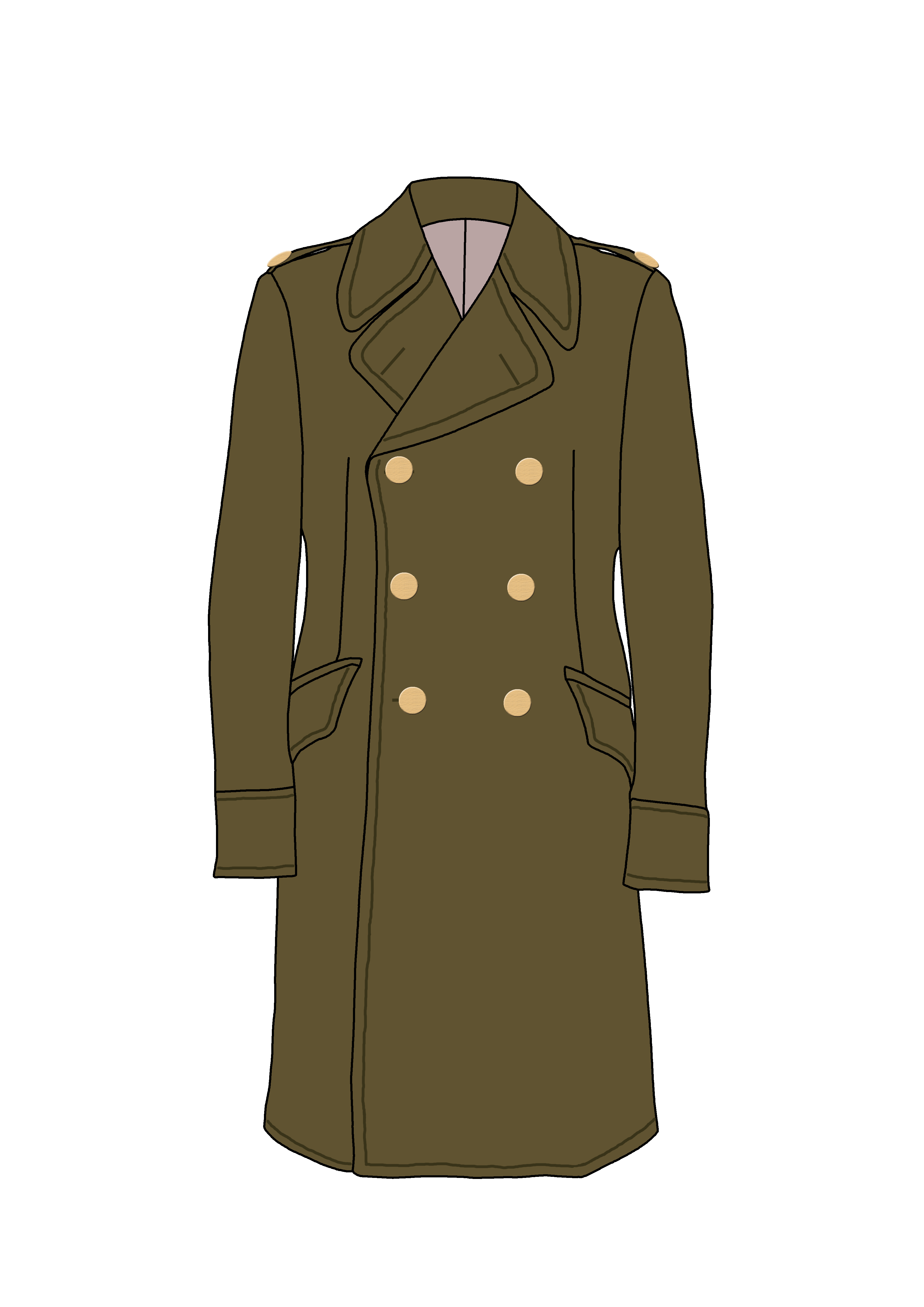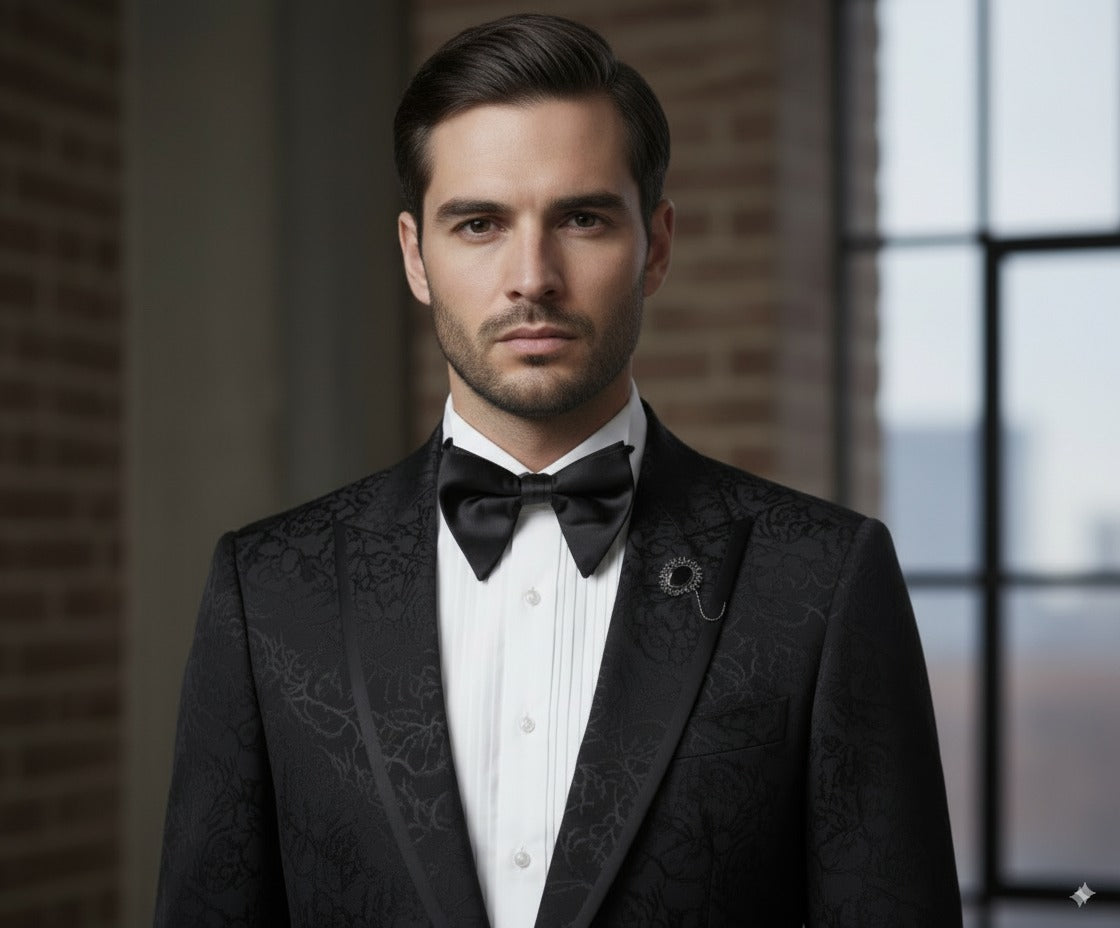
The Complete Guide to Overcoats: Part 2 – Military Heritage & Formal Elegance
Share
Welcome back to our comprehensive overcoat series! In Part 1, we explored the double-breasted overcoat, single-breasted topcoat, and the naval-inspired pea coat. Today, we're diving into three iconic styles that represent the pinnacle of military heritage and formal sophistication: the trench coat, the Chesterfield, and the military officer's coat. Each of these timeless designs offers unique benefits for both men and women seeking bespoke outerwear excellence.
The Trench Coat: Wartime Innovation Meets Timeless Style

Born in the muddy trenches of World War I, the trench coat has evolved from military necessity to become perhaps the most versatile and universally flattering overcoat style ever created. Its functional design elements—originally intended for combat—now serve as iconic style features recognized worldwide.
Historical Context:
Developed by Thomas Burberry in 1912 for British officers, the trench coat was designed to be lightweight, water-resistant, and practical for warfare. Its distinctive features each served a specific military purpose, from the gun flap to the D-rings for attaching equipment.
Tailoring Specifications:
Construction Details:
- Closure: Double-breasted front with 10 buttons (8-10 visible, depending on style)
- Belt: Self-fabric belt with metal D-rings and buckle closure at waist
- Lapels: Wide, notched lapels designed to be worn up with throat latch
-
Length:
- Men's: Traditionally knee-length (40-44 inches from collar)
- Women's: Versatile from above-knee (36-38 inches) to classic knee-length (40-42 inches)
- Storm Flap: Protective overlay across the chest and back (originally a gun flap)
- Epaulettes: Shoulder straps with button closure (originally for rank insignia)
Signature Design Elements:
Military Features Adapted for Civilian Wear:
- Raglan Sleeves: Set-in sleeves that extend to the collar, allowing greater arm mobility and easier layering
- Storm Shield/Yoke: Double layer of fabric across the shoulders and back for water resistance
- Wrist Straps: Adjustable buckled straps at cuffs (originally to seal out rain and gas)
- D-Rings: Metal rings at belt for attaching accessories (originally for grenades and equipment)
- Throat Latch: Adjustable strap at collar for additional wind protection
- Back Vent: Deep center vent with button closure for ease of movement
Pattern Considerations:
For Men:
- Shoulder construction: Raglan sleeve requires specialized pattern drafting
- Chest measurement: Generous ease (4-6 inches) for layering suits
- Waist definition: Belt creates adjustable fit; minimal body suppression
- Sleeve length: Must accommodate raglan construction while maintaining proper wrist length
- Back width: Generous across shoulders for movement and layering
For Women:
- Bust accommodation: Raglan sleeve construction naturally provides more bust room
- Waist emphasis: Belt placement critical—typically at natural waist or slightly below
- Hip proportion: Gradual A-line from waist to hem for feminine silhouette
- Sleeve pitch: Adjusted for typically narrower shoulders
- Length options: Shorter lengths (mid-thigh) create modern, fashion-forward look; knee-length maintains classic elegance
Fabric Selection:
Traditional Gabardine: The trench coat's signature fabric, invented by Thomas Burberry himself:
- Weight: 8-12 oz for traditional trench; 10-14 oz for year-round wear
- Composition: 100% cotton gabardine (traditional) or cotton-polyester blends for modern performance
- Weave: Tight twill weave with water-resistant finish
- Characteristics: Breathable, tightly woven, naturally water-repellent
- Color: Classic beige/stone (shown), navy, black, or olive
Modern Alternatives:
- Ventile Cotton: High-performance cotton that swells when wet to create waterproof barrier
- Waxed Cotton: Traditional British waterproofing for rugged durability
- Technical Fabrics: Modern blends with DWR (Durable Water Repellent) treatments
- Wool Gabardine: Heavier weight (14-16 oz) for colder climates
Hand-Tailoring Elements:
Despite its utilitarian origins, a bespoke trench coat requires exceptional craftsmanship:
- Raglan Sleeve Construction: Complex pattern drafting requiring 40+ cutting steps
- Storm Shield Attachment: Hand-sewn to maintain flexibility and drape
- Belt Loops: Hand-stitched and reinforced for durability
- Button Placement: Precisely positioned for proper overlap and fit
- Lining: Full lining in breathable cotton or silk (note the elegant mauve shown)
- Seam Finishing: Double-stitched and sealed seams for water resistance
- Epaulette Attachment: Functional buttons hand-sewn with reinforcement
Styling Versatility:
For Men:
- Wear over business suits for professional polish
- Layer over knitwear and chinos for smart-casual elegance
- Belt can be worn tied, buckled, or left open for different looks
- Collar worn up with throat latch for dramatic, classic styling
- Works equally well with dress shoes or casual boots
For Women:
- Belted at waist creates hourglass silhouette over dresses or suits
- Worn open and unbelted for relaxed, contemporary look
- Shorter lengths pair beautifully with heels and midi skirts
- Classic length works with trousers, jeans, or boots
- Can be styled masculine (straight fit) or feminine (belted and fitted)
- Perfect transitional piece from office to evening
The Chesterfield Coat: Aristocratic Elegance

Named after the 6th Earl of Chesterfield in the 1840s, this coat represents the epitome of refined, understated elegance. Its clean lines and minimalist design make it the most formal of all overcoat styles—the perfect choice for evening wear, opera, or any occasion demanding sartorial sophistication.
Historical Context:
The Chesterfield was originally designed for the British aristocracy as a formal overcoat to be worn over evening dress. Its distinguishing feature—the velvet collar—was both decorative and practical, protecting expensive suit collars from hair pomade and powder.
Tailoring Specifications:
Construction Details:
- Closure: Single-breasted with 2-4 buttons (3-button shown is most traditional)
- Collar: Signature velvet collar in contrasting color (traditionally black velvet)
- Lapels: Narrow notch lapels (2.5-3 inches) for refined appearance
- Silhouette: Straight, elegant cut with minimal waist suppression
-
Length:
- Men's: Falls just above or at the knee (40-44 inches)
- Women's: Knee-length or slightly shorter (38-42 inches) for proportion
- Pockets: Welted side pockets (no flaps) for clean, formal appearance
- Back: Typically no vent or single center vent for formal occasions
Signature Design Elements:
The Velvet Collar: The Chesterfield's most distinctive feature requires specialized construction:
- Material: Silk velvet or cotton velvet in black, midnight blue, or matching fabric color
- Width: 2-3 inches wide, proportioned to coat size
- Attachment: Hand-sewn to coat collar with hidden stitching
- Undercollar: Felt undercollar provides structure and comfort
- Maintenance: Velvet requires special care; can be replaced when worn
Minimalist Aesthetic:
- Clean front: No external embellishments or decorative elements
- Hidden closure: Buttons are functional but understated
- Sleek pockets: Welted pockets maintain smooth lines
- Refined proportions: Every measurement calculated for elegant silhouette
Pattern Considerations:
For Men:
- Shoulder line: Natural, slightly extended for layering formal wear
- Chest ease: 4-5 inches for wearing over suits and dinner jackets
- Waist suppression: Minimal (2-4 inches) for straight, elegant line
- Sleeve length: Must show 1/4 to 1/2 inch of shirt cuff
- Back length: Proportioned to height; taller individuals may require 44-46 inch length
For Women:
- Shoulder construction: Natural shoulder line with minimal padding
- Bust accommodation: Subtle darts or princess seaming for smooth fit
- Waist definition: Options from straight (masculine) to gently shaped (feminine)
- Hip curve: Slight A-line from waist prevents pulling across hips
- Sleeve proportion: Adjusted for typically narrower shoulders and shorter arms
- Collar scale: Velvet collar sized appropriately for feminine proportions
Fabric Selection:
Traditional Choices: The Chesterfield demands premium, formal fabrics:
- Weight: 16-20 oz for substantial drape and warmth
- Composition: 100% wool or wool-cashmere blends (90/10 or 85/15)
- Weave: Plain weave, twill, or herringbone in fine gauge
- Color: Black (shown—most formal), charcoal, navy, or dark grey
- Finish: Smooth, refined surface with subtle sheen
- Recommended Mills: Abraham Moon & Sons or Huddersfield Fine Worsted & our house cloths.
Fabric Characteristics:
- Drape: Must hang perfectly straight without pulling or wrinkling
- Weight: Substantial enough for formal occasions but not bulky
- Surface: Smooth finish that complements evening wear
- Durability: High-quality wool that resists wear and maintains appearance
Hand-Tailoring Elements:
The Chesterfield requires the highest level of craftsmanship:
- Velvet Collar Application: Hand-sewn with invisible stitching; 50+ individual stitches
- Canvas Construction: Full floating canvas from shoulder to hem
- Hand-Padded Lapels: Horsehair canvas shaped by hand for permanent roll
- Welted Pockets: Hand-welted with reinforced corners
- Button Attachment: Buttons sewn with thread shank for proper closure
- Lining: Full silk or Bemberg lining, hand-felled to body
- Sleeve Heads: Hand-padded for smooth shoulder line
- Hem: Hand-stitched with blind hem for invisible finish
Styling Guidelines:
For Men:
- Formal Occasions: Worn over dinner jackets, tuxedos, or dark suits
- Business Formal: Perfect with charcoal or navy suits for important meetings
- Evening Events: The only overcoat appropriate for opera, theater, or formal dinners
- Footwear: Requires dress shoes—oxfords, derbies, or formal boots
- Accessories: Pair with dress scarves, leather gloves, and formal hats
For Women:
- Evening Elegance: Stunning over cocktail dresses or evening gowns
- Business Formal: Sophisticated with tailored suits and heels
- Modern Styling: Can be worn with trousers and silk blouses for contemporary elegance
- Length Considerations: Ensure coat doesn't overwhelm dress or skirt length
- Accessories: Elevate with silk scarves, leather gloves, and statement jewelry
The Military Officer's Coat: Commanding Presence

Inspired by military greatcoats worn by officers from the 18th century through both World Wars, this style combines martial authority with sophisticated tailoring. The military officer's coat is characterized by its double-breasted front, distinctive shoulder details, and commanding length.
Historical Context:
Military greatcoats were designed to provide maximum warmth and weather protection while maintaining the officer's distinguished appearance. The double-breasted front, large lapels, and substantial length were all functional elements that have become iconic style features.
Tailoring Specifications:
Construction Details:
- Closure: Double-breasted 6x2 configuration with large military-style buttons
- Lapels: Wide, peaked lapels that can be worn upturned for protection
- Epaulettes: Structured shoulder straps with button closure (originally for rank insignia)
-
Length:
- Men's: Long—falling to mid-calf or just below knee (44-48 inches)
- Women's: Can be adapted from knee-length (40-42 inches) to elegant midi length (44-46 inches)
- Pockets: Angled flap pockets or slash pockets with button closure
- Back: Center vent or no vent; some styles feature back belt or half-belt
Signature Military Elements:
Epaulettes: The defining feature of military-inspired outerwear:
- Construction: Structured fabric straps extending from shoulder seam to collar
- Width: 1.5-2 inches wide, tapering slightly toward collar
- Closure: Functional button at collar end
- Reinforcement: Interfaced for structure and military bearing
- Styling: Can be worn buttoned (formal) or unbuttoned (casual)
Button Details:
- Size: Larger than standard coat buttons (28-32mm diameter)
- Style: Metal buttons with military motifs, crests, or plain brass
- Placement: Evenly spaced in two vertical rows
- Shank: Strong thread shank for secure attachment
Collar Construction:
- Height: Tall collar (2.5-3 inches) for neck protection
- Structure: Heavily interfaced to stand upright
- Roll: Can be worn open or closed at throat
- Lining: Soft lining at neck for comfort
Pattern Considerations:
For Men:
- Shoulder emphasis: Strong, structured shoulder line with military bearing
- Chest measurement: Generous ease (5-7 inches) for layering heavy knitwear or suits
- Waist definition: Moderate suppression (6-8 inches) maintains masculine silhouette
- Length proportion: Longer length requires careful balance with height
- Sleeve construction: Set-in sleeves with structured sleeve head
- Back width: Ample across shoulders for movement and layering
For Women:
- Shoulder structure: Can be softened while maintaining military inspiration
- Bust accommodation: Princess seaming or darts integrated into military styling
- Waist emphasis: More pronounced suppression (8-12 inches) for feminine silhouette
- Hip curve: Gradual flare from waist accommodates curves
- Length adaptation: Shorter lengths (knee or just below) maintain proportion on smaller frames
- Epaulette scale: Sized appropriately for feminine shoulder width
- Optional belt: Self-fabric belt or half-belt enhances waist definition
Fabric Selection:
Traditional Military Fabrics:
- Weight: 20-28 oz for substantial warmth and structure
- Composition: 100% wool Melton, heavy twill, or wool-cashmere blends
- Color: Olive/khaki (shown), navy, charcoal, or camel
- Characteristics: Dense, windproof, water-resistant
- Finish: Matte surface with military bearing
Recommended Fabrics:
- Melton Wool: 24-28 oz, heavily fulled for maximum warmth
- Cavalry Twill: 20-24 oz, diagonal weave for durability
Perfect! Here's the completed ending for Part 2 in the same style:
Choosing Your Perfect Heritage Overcoat
Each of these classic heritage styles serves distinct purposes in a sophisticated wardrobe:
Choose the Trench Coat if:
- You need versatile, all-weather protection for unpredictable climates
- You value functional design elements with timeless style appeal
- You want a coat that effortlessly transitions from business to casual settings
- You prefer lighter-weight outerwear for spring, autumn, and mild winters
- You appreciate iconic, universally recognized style that never dates
- You travel frequently and need packable, wrinkle-resistant outerwear
Choose the Chesterfield if:
- You attend formal events, opera, theater, or black-tie occasions regularly
- You need the most sophisticated option for business formal environments
- You prefer understated, refined elegance over bold statement pieces
- You want a coat specifically designed to complement evening wear and dark suits
- You value traditional craftsmanship and aristocratic heritage
- You work in conservative professional fields requiring impeccable presentation
Choose the Military Officer's Coat if:
- You want commanding, authoritative presence in your outerwear
- You need maximum warmth and protection for severe winter weather
- You appreciate structured, military-inspired design with historical significance
- You prefer longer-length coats for dramatic, statement-making effect
- You embrace bold styling that stands out from conventional business wear
- You have the height and build to carry substantial, structured garments
Styling Considerations
For Men:
The Trench Coat:
- Wear belted over suits for classic business styling
- Leave unbelted with collar popped for casual weekend elegance
- Ensure sleeves show 1/4 to 1/2 inch of shirt cuff
- Pair with dress shoes for formal; boots for casual
- Layer over knitwear and chinos for smart-casual versatility
The Chesterfield:
- Reserve for formal occasions—dinner jackets, dark suits, evening events
- Keep styling minimal and refined—let the coat speak for itself
- Pair exclusively with dress shoes; never casual footwear
- Ensure trousers have minimal break for elegant proportions
- Add silk scarf and leather gloves for complete formal presentation
The Military Officer's Coat:
- Wear over heavy knitwear for maximum cold-weather protection
- Balance substantial length with appropriate trouser break
- Pair with substantial footwear—boots or heavy brogues
- Keep epaulettes buttoned for formal; unbuttoned for relaxed styling
- Consider height—taller men (6'0"+) carry longer lengths best
For Women:
The Trench Coat:
- Belt at natural waist to create hourglass silhouette over dresses
- Wear open and flowing for contemporary, relaxed elegance
- Shorter lengths (above-knee) pair beautifully with heels and midi skirts
- Classic knee-length works with trousers, jeans, or tall boots
- Experiment with masculine (straight, unbelted) vs. feminine (cinched, belted) styling
- Perfect for transitional dressing from office to evening
The Chesterfield:
- Stunning over cocktail dresses, evening gowns, or formal suits
- Ensure coat length doesn't overwhelm dress or skirt hemline
- Pair with heels for elegant proportions
- Keep accessories refined—silk scarves, leather gloves, statement jewelry
- Consider straight fit for androgynous chic or shaped waist for feminine elegance
- Perfect for opera, theater, gallery openings, and formal dinners
The Military Officer's Coat:
- Belt at waist for powerful, feminine silhouette
- Wear straight and unbelted for fashion-forward androgynous styling
- Longer lengths create drama with heels; shorter lengths versatile with boots
- Balance military structure with feminine accessories or embrace full utilitarian aesthetic
- Layer over suits for executive authority or dresses for unexpected contrast
- Consider frame—petite figures may prefer knee-length; taller women can carry midi length
Fabric & Color Selection Guide
Climate Considerations:
Mild/Temperate Climates (Spring/Autumn):
- Trench Coat: 8-12 oz gabardine or lightweight wool
- Chesterfield: 14-16 oz wool or wool-cashmere blend
- Military Officer's Coat: 18-20 oz wool twill
Cold/Winter Climates:
- Trench Coat: 12-14 oz wool gabardine with removable lining
- Chesterfield: 18-20 oz heavy wool or cashmere blend
- Military Officer's Coat: 24-28 oz Melton wool or heavy cavalry twill
Color Versatility:
Maximum Versatility (Pairs with Everything):
- Navy (works with all colors except black)
- Charcoal grey (sophisticated neutral)
- Camel/beige (classic for trench coats)
Formal Occasions:
- Black (Chesterfield—most formal)
- Midnight navy (elegant alternative to black)
- Charcoal (business formal)
Statement Colors:
- Olive/khaki (military officer's coat—heritage authenticity)
- Burgundy (sophisticated alternative)
- Forest green (distinctive, heritage-inspired)
Investment & Longevity
A bespoke overcoat represents a significant investment in your wardrobe, but when properly cared for, these garments can last 20-30 years or more. Consider:
Cost Per Wear:
- A £499 -£1499+ bespoke overcoat worn 50 times per year for 20 years = £0.04-£1.49 per wear
- Compare to fast-fashion coats requiring replacement every 2-3 years
Timeless Design:
- Classic styles never go out of fashion
- Quality construction maintains appearance for decades
- Can be refreshed with new lining or buttons
Sustainability:
- One well-made coat vs. multiple disposable alternatives
- Premium fabrics from sustainable mills
- Traditional craftsmanship supports artisan skills
The A Hand Tailored Suit Difference
At A Hand Tailored Suit, every overcoat begins with a blank canvas—your unique paper pattern. Whether you're seeking traditional masculine tailoring, elegant feminine cuts, or androgynous styling, our process includes:
✂️ Comprehensive Measurement: Using our AI-powered contactless measurement technology or traditional in-person measurement—adapted for all body types and proportions
📐 Bespoke Pattern Creation: Over 35 cutting steps tailored to your posture, proportions, and style preferences—ensuring perfect fit regardless of body shape
🧵 Hand-Tailoring Excellence: 290+ individual stitching operations per garment, combining traditional Savile Row techniques with modern innovation
🎨 Fabric Consultation: Access to premium mills including Abraham Moon & Sons or Huddersfield Fine Worsted & our house cloths. —with expert guidance on weight, color, and performance
👔 Style Consultation: Expert guidance on cuts that flatter your unique silhouette—masculine, feminine, or anywhere in between—with no judgment, only expertise
⏱️ Flexible Timelines: Standard 8-week creation for traditional bespoke process, or fast-track options (2, 3, or 4 weeks) for urgent requirements
💰 Transparent Pricing: Bespoke Trench-coats Starting from £499 for 2-piece suits | £899 for 3-piece suits.
Coming Up in Part 3: The Ulster, Loden & Duffle Coats
In our final installment of this comprehensive overcoat series, we'll explore three distinctive styles that combine rugged practicality with timeless appeal:
The Ulster Coat: Born in Northern Ireland in the Victorian era, this dramatic design features a distinctive cape or shoulder overlay and represents the height of 19th-century tailoring sophistication. We'll explore its architectural construction and how to wear this statement piece in modern contexts.
The Loden Coat: An Alpine classic originating in Austria and Bavaria, the Loden coat showcases unique boiled wool fabric and traditional Tyrolean styling. Perfect for country pursuits, outdoor activities, and those who appreciate Central European heritage craftsmanship—we'll detail its unique fabric properties and construction.
The Duffle Coat: Originally worn by the Royal Navy in World War II, this hooded coat with its distinctive toggle closures has evolved from naval necessity to beloved casual classic. We'll examine how this utilitarian design has been adapted for both men's and women's wardrobes while maintaining its practical heritage.
Each of these styles offers unique benefits for different lifestyles, climates, and aesthetic preferences. Part 3 will complete your education in classic overcoat styles, ensuring you have the knowledge to choose the perfect bespoke coat for your needs.
Ready to Begin Your Bespoke Overcoat Journey?
Choosing the right overcoat style is a significant investment in your wardrobe and your personal style. Whether you're drawn to the versatile functionality of the trench coat, the aristocratic elegance of the Chesterfield, or the commanding presence of the military officer's coat, our team at A Hand Tailored Suit is here to guide you through every decision.
Book a consultation to discuss:
- Which style best suits your lifestyle, climate, and wardrobe needs
- Fabric selection for your specific requirements and budget
- Customization options for truly personal style expression
- Fit considerations for your unique proportions and posture
- Timeline and pricing for your bespoke overcoat project
- Care and maintenance for decades of wear
Contact us:
- Website: ahandtailoredsuit.com
- AI-Powered Measurement App: Download for contactless precision fitting
- Showroom Appointments: Available for in-person consultations and fabric selection
With over 250 five-star Trustpilot reviews and decades of experience creating bespoke tailoring for men, women, and children, we're committed to crafting outerwear that combines traditional Savile Row craftsmanship with modern innovation—for every body and every style.
Read the Complete Overcoat Series:
- Part 1: Double-Breasted, Topcoat & Pea Coat Styles
- Part 2: Trench Coat, Chesterfield & Military Officer's Coat (You are here)
- Part 3: Ulster, Loden & Duffle Coats (Coming soon)
A Hand Tailored Suit – Creating custom bespoke tailoring for men, women, and children. Where traditional craftsmanship meets contemporary style. Ranked 7th top tailoring blog by FeedSpot.
Bespoke Trench-coats from £499 | 2-piece suits from £699 | 3-piece suits from £899 | Standard 8-week creation or fast-track options (2, 3, or 4 weeks) available
Traditional bespoke craftsmanship: Over 290 stitching operations | 35 cutting steps | Unique paper patterns | Premium fabrics from world-renowned mills | AI-powered fitting technology
"PEOPLE WILL STARE. MAKE IT WORTH THEIR WHILE" - HARRY WINSTON -
A Hand Tailored Suit, the bespoke tailoring company offering you a slice of London’s Savile Row, for a cut of the cost.
If you have a special event or wedding to attend, an autumn gathering, or a cozy office fall celebration, we can create a unique bespoke ensemble just for you. From hand-crafted wool and tweed jackets to custom shirts, corduroy pieces, and merino wool tailored trousers perfect for the season’s crisp air.
Get in touch with our talented tailoring team today.
You can either design online or book in with one of our talented tailoring team. All garments are hand-made to fit your unique body pattern & size.

